can you tell i’m jonesin’? i miss my writing . . .
i have not allowed myself to even think about blogging this week til now. i’ve been buried deep in the pattern writing trenches. very deep.
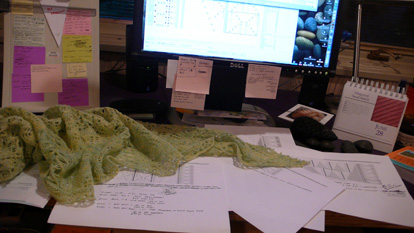
that is, when i’m not doing my job, which has been hectic this week. i have these documetns i’ve been getting back where each of the, oh, 100 or so pages looks like a cy twombly drawing gone awry. i SO wish i could show you some of them—seriously, they are hiLARious—just one rat’s nest of markups after another (it’s my job to sort out what the proofers wrote, and then pick through the digital text and fix it. fun, huh? oh yeah, and make sure it all still fits on the page AND looks pretty).
but i’ve been very diligent and have finally gotten the first part of the bee pattern out to the test knitters. see?
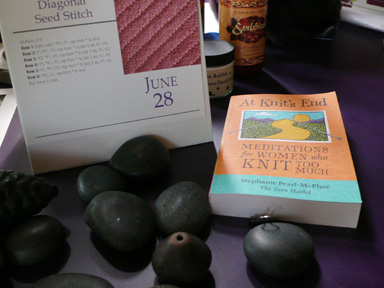
i don’t even have a sock on my desk. in fact—and you might want to sit down for this—i have just one project on the needles right now, and it’s a sock.
the pattern writing part is good, though when i first saw the pattern notes that were exported from the charts, i almost passed out. well, heh, there’s a lot going on in the bee shawl.
not to worry; none of it is very difficult to knit, but the choreography and orchestration are somewhat challenging. and it’s always a big job to make something easier for the end user, which is sort of a thing with me.
patternmaking is a very interesting vocation. i’ve been doing it professionally now for a long time—about 25 years, first in the dress-and-costume trades, then in knitwear. and i’ve always worked with one-off, couture, or first patterns. that is, i have spent a lot of time translating ideas into hardcopy.
as a first-pattern cutter, you are given all sorts of descriptive material—sketches, swatches, verbal descriptions, photos of similar shapes—and little, if any, actual data or tangible model to work off of. you begin by draping fabric on a dress form, and sculpting it with scissors and pins into what you think the designer wants. then you go back and forth, stitching and honing it til it is either overworked and awful, or until it clicks and is wonderful. then you take it apart and make a pattern from that.
with knitting, it’s even better—you have to create the fabric AS you sculpt it.
in both cases, the wider, and more well-absorbed your experience, the more informed your choices are (i.e., you guess right more often). and in both cases, you will do a LOT of math; you will do a lot of redoing, too.
the work gets more and more concrete the closer you get to the end of the process.
it all starts out as a swirl of beautiful abstraction, and it all comes down to knowing the exact number of stitches you will have after repeating a 12-st pattern plus 3 nine times more plus the edge stitches and doubling that, then add 1 stitch. and you BETTER be right.
and the thing is, i love it. i love all that stuff. the idea that there is a process by which i can take the impressions of light, scent, sky, and sound, find a fiber that feels like that, knit it up into patterns that look like those things, and THEN turn it all into numbers and graphs on paper so that other people can do it too, just floors me.
i’ve been thinking a lot about the connection between mathematics, physics, and knitting, admittedly partly due to the job i was talking about earlier. i’m working on a book about how to teach high school students, and i’ve noticed, not for the first time, that when i work on the math and science parts, i literally have moments when my heart races from excitement (out of boredom, i often read the material i am formatting—i know—just think of it as a kind of multitasking . . . instead of what it really is). i mean it—my heart thumps from just rubbing elbows with math theory.
i have similar moments with knitting and designing, in case you were still in any doubt about the breadth of my nerdiness. social science, history, and business just don’t attract me in the same way, although visual art knocks my socks off too.
don’t get me wrong—i am far from being fluent or even literate in higher math and science. i just love the ideas and reactions they cause in my mind. i literally have visions of stuff i could make from reading about math and science.
check it out—at the end of the post, there’s a selection of book titles from a resource list in the book i’m working on; i’m thinking i might need to read some of them.
ok, i’ll stop being weird now, and show you a few more pictures. because there has, at least, been good food this week
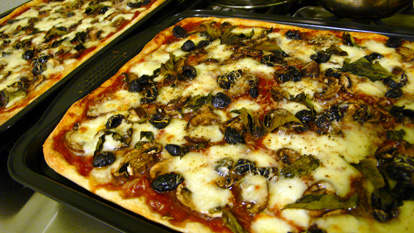
mmmm—pizza. with the last of last year’s tomatoes and herbs from this year’s garden
and then, the other day, i came downstairs from a quick nap late in the afternoon, and this was in the hallway
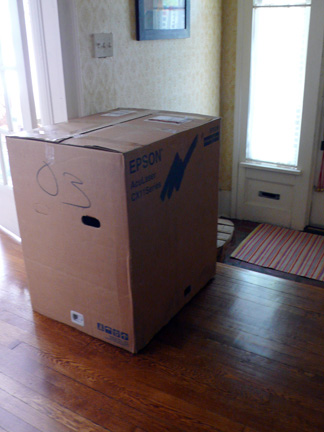
hmmm.
in case you aren’t fully appreciating the size of this box, i took a picture of it dwarfing juxtaposed with my town bike
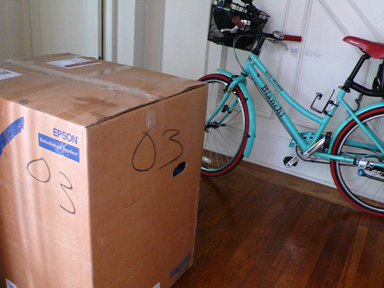
and from every angle we have a hint as to the contents. the light dawned so bright that i though my head would crack open.
david, is this the new printer?? (hey, i never said i was quick)
heh. (see, this is why he didn’t get to pick out my new camera last year.)
ok, i did remember that we discussed buying a much better printer, seeing as how i am printing almost constantly, and the old one was emitting streaky prints sometimes, for all it’s brilliantly turtlelike charm (translation, i was getting close to pitching it through a window . . . and we all know how that fax machine drawer got broken).

is it muhummed or the mountain?
well this thing is a wee bit bigger than i’d expected. but it prints lots of pages really fast and very crisply, which is a vast improvement over the old one. it replaces several of our ancient office machines (we are recycling those by selling them on ebay) and frees up a lot of surface area on our desktops.
so, it’s official—we are serious about the pattern printing business (we still prefer digital documents, but if we have to use paper, i’d rather it look great and use a minimum of supplies).
ok, that’s all for today. here’s the book list i promised—i just KNOW some of you are with me on this (oh shoot, just humor me so i don’t ever know i’m the only one) . . . and, ahem, i have full-length lists for anyone who wants them . . .
math books
Abbott, E. Flatland: A Romance of Many Dimensions.London: Seeley & Co., 1884. 1985.
tell me you’re not curious
Boles, M., and R. Newman. The Golden Relationship: Art, Math, and Nature—Book 1: Universal Patterns. 2nd ed. Bradford, MA: Pythagorean Press, 1992.
everyone needs a golden relationship
Burger, Dionys. Sphereland: A Fantasy about Curved Spaces and an Expanding Universe. Translated by Cornelie J. Rheinboldt. New York: Crowell, 1965.
are you with me yet?
Cromwell, P. Polyhedra. New York: Cambridge University Press, 1999.
c’mon! polyhedra; who could resist?
Devlin, K. J. Mathematics, The Science of Patterns:The Search for Order in Life, Mind, and the Universe. New York: Scientific American Library, 1994.
ok, i think this one is my favorite and might move to the top of the list. if knitting isn’t the search fro order in life, mind, and the universe, then what the heck am i doing with my life?
Garland, T. H. Fascinating Fibonaccis: Mystery and Magic in Numbers. Palo Alto, CA: Dale Seymour Publications, 1987.
Grafton, C. B. Optical Designs in Motion with Moiré Overlays. New York: Dover Publications, 1976.
if this book isn’t chock full of knitting inspiration i’ll be really stunned
Huntley, H. E. The Divine Proportion: A Study in Mathematical Beauty. New York: Dover Publications, 1970.
anything that’s divine has to be on my bookshelf
Livio, M. The Golden Ratio: The Story of Phi, The World’s Most Astonishing Number. New York: Broadway Books, 2002.
hhmmm. the MOST astonishing number, eh . . . tell me you’re not wondering . . .
Locke, J. Isometric Perspective Designs and How to Create Them. New York: Dover Publications, 1981.
i want to create them—you betcha!
Mandelbrot, B. B. The Fractal Geometry of Nature. San Francisco: W. H. Freeman, 1983.
Miyazaki, K. An Adventure in Multidimensional Space: The Art and Geometry of Polygons, Polyhedra and Polytopes. New York: Wiley, 1986.
Pearce, P. Structure in Nature Is a Strategy for Design. Cambridge, MA: MIT Press, 1978.
Peitgen, H. O. The Beauty of Fractals: Images of Complex Dynamical Systems. New York: Springer-Verlag, 1986.
Stevens, P. S. Handbook of Regular Patterns: An Introduction to Symmetry in Two Dimensions.
Turner, H. Triad Optical Illusions and How to Design Them. New York: Dover Publications, 1978.
science books
Cole, K. C. The Hole in the Universe: How Scientists Peered over the Edge of Emptiness and Found Everything. Harvest Books, 2001.
ok, that’s the limit . . . i have GOT to see what’s beyond the edge of emptiness
Einstein, Albert. The World As I See It/Out of My Later Years. Quality Paperback Books, 1990.
Feynman, Richard. Six Easy Pieces: Essentials of Physics Explained by Its Most Brilliant Teacher. Perseus Books Group, 1996.
Greene, Brian. The Elegant Universe. Vintage, 2003.
this is so simple, so beautiful, so-o-o . . . elegant a title; it’s a must-read
Macaulay, David. The New Way Things Work. Houghton Mifflin/Walter Lorraine Books, 1998.
Teresi, Dick. Lost Discoveries: The Ancient Roots of Modern Science—from the Babylonians to the Maya. Simon & Schuster, 2002.
Macaulay, David. Building Big. Walter Lorraine Books/Houghton Mifflin, 2000.
This book discusses the building of dams, domes, skyscrapers, bridges, and tunnels.
Skurzynski, Gloria. Waves: Electromagnetic Universe. National Geographic Society, 1996.
seriously, i’m going to read some of these.

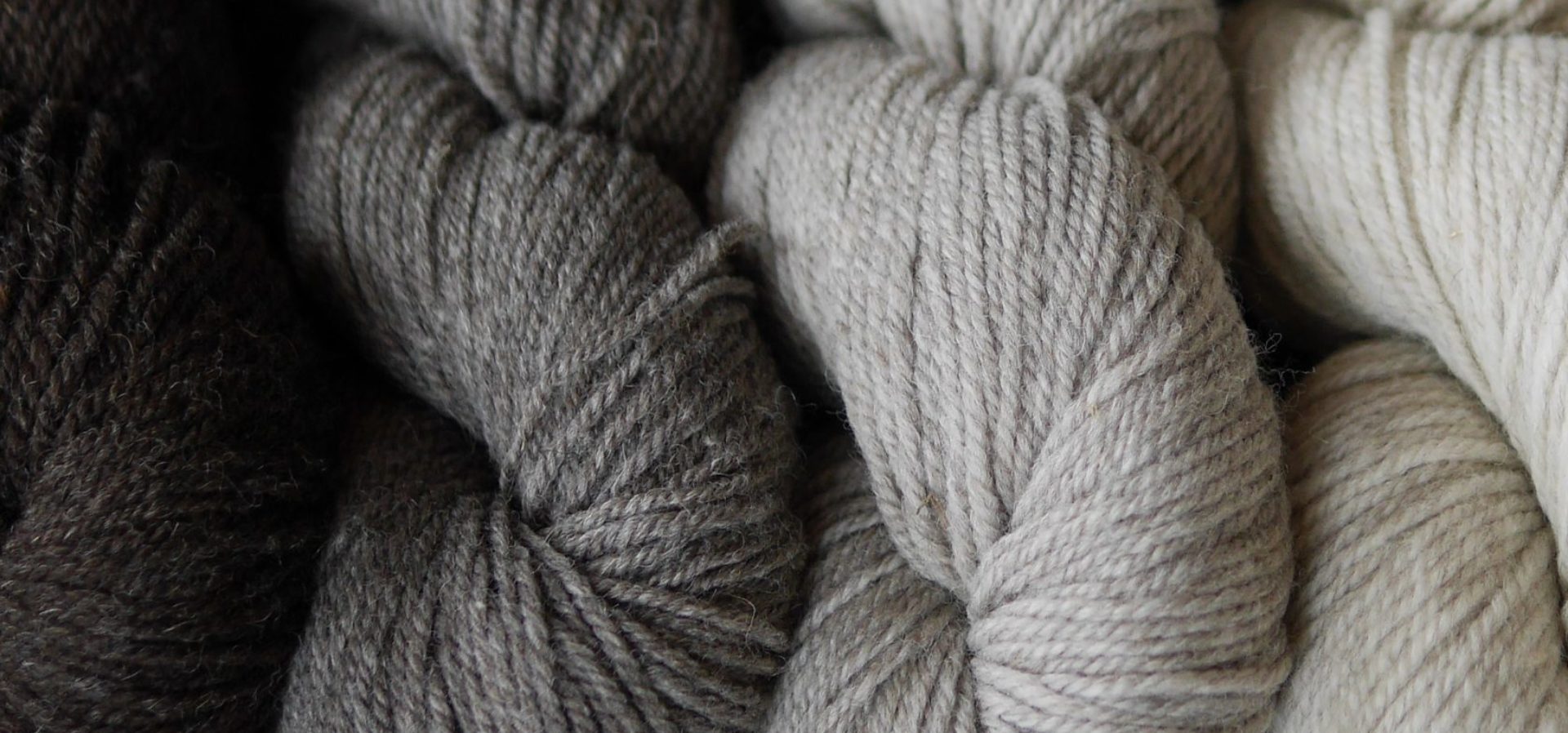
66 thoughts on “YAY!! i get to blog today”
You reminded me of how much I enjoyed studying biology and anatomy, and how exciting it was to learn about the development, function, order, intricacy of chemical reactions… well you get the idea. I enjoyed hearing about your background in pattern making – translating it from an idea to tangible numbers so that it can be replicated by anyone. Kind of makes my head spin.
I vote for a MathLace series!
I’m with you on the math and science thing, if it’s any consolation. Today was my last day of high school ever, and with it goes my studies in physics and calculus (I’m going on in music…)
I’m worried I’ll never use them again : (
OK, our little mind-meld thing ends with the math/science topic. Sad, but true. However, I’m proud to say that I own, and have read, Flatland: A Romance of Many Dimensions and I like it very much!
Way to go on the behemoth printer!!
That printer is the VERY reason my husband does not get to buy anything that will be staying in the house until I have actually seen it. Holy *%$! that’s a HUGE printer! I hope it works really, really well, or looks really, really good with a table cloth draped over it and can seat 12.
I’ve never been into math and science. I was always a wordy type–in an all-science family. And now I have two sons, one of whom is a science geek and the other of whom is a math whiz. And my husband is a former aerospace engineer.
I totally believe in the math/knitting connection – my husband and I are both engineers and when I finished my first sock – we were both in awe of how well engineered the design was. In a similar vein, I find “reading” charts far easier than text patterns.
Okay Anne, I do get what you’re saying totally! I’m really mathmatically challenged, but I’ve always loved and adored science!! Biology and humand physiology were two of my best subjects in high school. I just got so absorbed in learning about how people got their eye color, and how genetics play a role in so many factors of why we are the way we are. I also love to study things like the sky, and plants and flowers, a good sunset really knocks my socks off! I’m very visual though, I love art and color and how you can translate that into fabric or fibers.
David Macaulay is awesome. If you haven’t read it, you should definitely check out his _Great Moments in Architecture_.
Wow!!! You are up late, too.
Mandelbrot’s fractal book is terrific. I have to read much of it more than once to visualize what is going on, but I have found it absolutely facinating. The data consultant for our district had a copy of it that he bought at a garage sale — and I want a copy, too, but for a lot less than I have found it on alibris…
I was a mediocre math student until I started teaching math, then designing knitware and writing patterns. Practical application is the way to go. And I found a website for teaching kids math concepts with knitting:
http://cf.synergylearning.org/DisplayArticle.cfm?selectedarticle=373
It’s from Connect, a magazine on innovative math education for teachers. It tat had been around when I was in school (when the dinosaurs walked the earth) I might have learned a lot more.
YAY!! You’re back. Lots of interesting stuff in today’s post, including your pattern-making past and that fine list of books. You remind me that I really should find a good basic book on string theory–but even if I find one, I’ll probably still reach for the British mysteries at bedtime.
🙂
I’m with you! I’m a microbiology graduate student, which I’m pretty sure qualifies me as a science nerd (in the best way) regardless of other interests, and I’m certainly intrigued by that list of books! Aside from the biology, I’m also obsessed with big engineering projects, so I really might have to get my hands on the “Building Big” book, which sounds right up my alley. As for math, I’d be SO happy if I could use my college calculus for something in my current job – I loved doing derivatives way more than was probably healthy…
I’m so glad I can leave the mathematics to you !
Seriously, I’m hopeless in it ! Isn’t it wonderful that you can do what you really LOVE to do in designing patterns 🙂 And that you get such a thrill out of it ?
just reading about how excited you get about how math and science correlate with knitting gets me excited about it! i’m tempted to pick up a few of those titles now, even though i know that most of it would go right over my head.
When will you find the time to wade through that reading list?! Too bad they don’t put the books on audio, because then you could listen as you knit. That sounds like it would be heaven for you. And if the concepts in the reading make your heart race, just think how much faster you’d knit!
I’m fascinated by your fascination with math. I’m a social sciences girl myself. 🙂
I’m with you on science, not so much on maths. 🙂 The science ones look really interesting!
I might check a few out!
When I checked proof, earlier in my career, my boss used to get on me because I wasn’t supposed to read the books (at that time science texts). Eventually I gravitated to a job where I do read the texts as I edit them, and people are always surprised that I ask for the harder math-based disciplines, and I’m delighted when I get a manuscript for more advanced students. It is nice to know there’s someone else out there like me! That is quite a list. I must admit, though, that for fun I like to read novels or history books. At the end of a day in which I’ve slogged through less-than-beautiful prose, I like to see a master at work with the English language.
And I always thought that those perfect patterns emerged fully formed from the designer’s mind, particularly as I currently struggle with details on my own sweater design. But knitting is so forgiving because you can rip and start over.
Algebra used to excite me that way but then I blundered into geometry … and even worse, pre-calc. Kind of killed math excitement for me. Words – now those kick start my neurons. But I do understand what you mean about designing. It fascinates me, though I’m not (yet) very good at it (in no small part because I haven’t done much). I read Cat Bordhi’s books and know if I had 3 wishes granted me, one would be to spend 24 hours inside her brain to see what goes on in there. I’m guessing I’d be in for an exhilarating ride well worth the time. Sounds like I’d have similar time in your brain. 🙂
math and science were always my favorite subjects for many of the same reasons – the why and theory behind it…..it’s interesting to see it applied to knitting! Reading patterns (fabric or knit) is interesting – to see how each designer thinks and puts it together. Like a “why did she do this instead of this?” moment. As you were talking about your jobs in the couture fashion world, i kept thinking about Project Runway and how they had to create on the fly and I always though “what if someone had to come up with a pattern for that?? how in the world would they reproduce it??”
wonderful reference list. thanks.
awesome printer- but I feel for you with the ink. do you refill or have to get cartridges? they kill ya’ with those!
You are awesome.
It gets so depressing sometimes when I read about how this or that knitter hates math or claims not to be able to understand math and therefore avoids it, and I just want to scream, “Try it! Math is fun! I love math! Math math math!”
Nerds are my favourite things in the world.
Thank you for doing the math, guiding us dunderheads by the hand so we can make beautiful things too. I’ve really tried to get it, even taking on-line classes,reading books, flash cards. I’m 48 and still can’t remember my multiplication tables. Instead, my mind wanders off and gives numbers personality: Oh, One is SO important, Two tries to get along with everyone, Three is passive-aggressive, Four an enabler…well you get my drift. Then they argue with each other–you should see the matches between four and eight, (eight’s SO needy)…
See. You’re not weird. That new printer is so…what I want!
What a truly wonderful post. I usually breeze through knitting posts that don’t have a bunch of pictures but then I grazed over my favorite word “Math”. I’m actually trying to designa pair of socks for the Summer of Socks contest. This is my first time taking a specific vision that I have in my head and trying to translate it into a knitted fabric. Your post is oh so helpful and gave me tht little bit of encouragement to strive on in my sock designing quest. I minored in Applied mathematics in school and because it doesn’t apply to my current full time job, I’m always looking for ways to put it to use, hence knitting. I just wanted to let you know what a great resource this post is. Thanks!
Back in the day I had to take Calculus and Vector Analysis for Engineering, I loved the Calculus part, but alas, partying in college took priority. Now that I’m older, I would love to brush up on that stuff to keep the ol’ noggin sharp, it’s since been dulled by the daily grind and thousands of diaper changes 🙂 That pizza looks YUM-O! Your dedication to your craft is amazing to me, I can’t wait to see the pattern for the Bee Shawl when it comes out!
Emily – I am a musician, and I have to tell you, though I haven’t actually taken a math class since high school, you are horribly mistaken if you think that music doesn’t involve math. They hide this fact from you until theory 4/advanced theory/20th century theory. Dodecaphonics, hexachordal combinatoriality, and all that. Except the math is based on 12 instead of 10. Don’t worry, you’ll work up to it. Just don’t be surprised when they suddenly assign notes numbers…. Good luck!
I’m totally with you on the connections between math and knitting, and, well, math and life. I’m right in the middle of deciding whether to give up my rather lucrative career and teach high school math for the next ten years. Just took the licensure exam, and was relieved that 35 years after my last math class–I nailed the thing.
Oh, you are so left-brained. . .but wait, what about all of that creative brilliance flowing from your brain? Even though I abhor math, I do know that knitting would be a whole new world if I had a left brain at all1 I love rocks! Those are rocks on your desk, right?
I have to say it took me years (and 3 tries) to finally “get” algebra. But…that said, once it “clicked?” ummm…let’s just say that some of those math books are seriously seductive…
It makes so much sense, tho’. Knitting lace and math – so MUCH sense.
(((hugs)))
It’s so interesting reading a bit about your design process and the translation into written pattern form. I love getting that little glimpse into the mind of a mad genius!
We’ll forgive you for your math-nerdiness, since I’m sure it contributes to your pattern-writing skills 🙂
I’ve often thought that, if I had realized that there was so much math in knitting, I never would have picked up the needles. I am NOT a math person, yet I use it a lot in knitting, from gauge to lace and figuring stitch patterns as I try my hand at a bit of designing here and there. My son, however, is the one who really has it going on–he loves higher math, and is also a talented artist; perhaps it’s related to his being somewhat ambidexterous, right and left brains working together. Your booklist gives me some ideas about Christmas presents for him!
I’m right with you on the math – I would LOVE to go back to university and do a math degree, just for the sheer fun of it. Meanwhile, I shall bookmark your list… 🙂
I love knowing how things work, too, and while biology was never a favorite of mine (in fact, I avoided it all through high school and college), there’s something appealing about the math/science thing as it explains the world. Even if I did stop at Trigonometry in school. But it’s also part of the reason I enjoy writing puzzles for my company’s newsletter–I love the tricky ins and outs of putting down the answers and then working backwards to the starting point for everyone else. (And the extra thrill of knowing all the answers myself doesn’t hurt…)
Holy moley, that’s a big-ass printer! 🙂 I imagine you will be head over heels for it before very long. 🙂
And I am so happy to hear that the Bee is off to the test knitters! 🙂 BTW, does it have an ‘official’ name? I’ve been wondering about that. 🙂
What about some design books? Learning to design? You know for those of us still dreaming of designing out own knits? LOL.
Actually i love your choice of science books and the pizza looks so yummy I have to log off and go get lunch.
Kaffe Fassett once said he takes his inspiration from everything he sees – everything!
I remember making string art in jr. high math class by pounding nails into a square of plywood, then stringing different colored threads back and forth across the center. Lots of fun and hopefully some educational benefit.
See? I’ve always played with string…
Blessings!
Flatland was fricking hilarious. I haven’t read Sphereland, mabbe I should give that one a go. I love Richard Feynman, too–he was the source of my constant mantra during my Quantum Mechanics class a few years ago, “No one understands quantum, no one understands quantum…”
As an elementary school teacher, I’ve used Mario Livio’s “The Golden Ratio”(as well as other math theory books) in my work. Both with gifted and struggling students I’ve found that the concept of the “beautiful number” resonates. We’ve had some amazing science, math and art projects come out of this work. I know what you mean about fairly swooning with the concepts. I was a very dismal math student throughout school; it wasn’t until I began doing my thinking about teaching math that my math brain came alive. What a buzz! 🙂
I read Flatland back in high school… I remember loving it!
I’m thinking I’ll have to check some of these titles out of my local library (though I *have* read some of them already).
Funny, I don’t think of myself as a math lover… but maybe it’s just the rote arithmetic I dislike… the conceptualization and manipulation of numbers… oh yeah, that’s cool.
A good printer is an excellent investment. And I’d love to see the full reading list. I’m always looking for interesting books. I’m excited to learn the bee shawl is off at test knitters already.
I always enjoy reading about your design process and how much you enjoy it.
After trying to be a theoretical math major for a couple of years (and being miserable), math books just don’t excite me.
I just had a flash-back to my Junior year in High School!!! I went to the High School of Fashion Industries here in New York City. 4 years of Fashion Design.
I am now a legal secretary who HATES ironing!
Thanks for the list. It reminded me to get back to some of those books that were on my list too. Definitely read Flatland – it’s a classic. But Planiverse, by A K Dewdney, takes the whole idea and really runs with it – it’s a must for those who think they hate math but like novels.
Translating the experience into the stitches: yes. That’s it exactly for me!
I completely grok the math-science-visual design continuum. In reality, there is no disconnect. People who claim to be math-challenged but are whizzes at 3-D rendering for instance simply have a different way of explaining (or representing) the same thing.
As an art historian, think of the evolution of representational art from flat to multi-dimensional through the use of orthogonals for perspective and chiaroscuro for shaping. These same principles can be found in calculus, geometry, physics and biology. Nothing really stands alone.
I also love how math, knitting, and music all go together. Maybe that’s why my degree is in math (though I did major in music for a while), and have been knitting most of my life! I love how numbers work, and often find myself figuring out simple calculations by hand and verifying with a calculator, since I enjoy numbers so much. I love figuring out how and why something is done. Even now, my current project is something that I’m adjusting even bigger than the largest size the pattern is written for, and I’m finding it fun to recalculate stitch numbers and directions.
Can’t wait to put those books in my to-read list! (and yes, I’ve read your blog for a few months now, and this is my first post).
Home made pizza, nothing like it, a favourite in our house. Thanks for working on the bee so diligently so the rest of us can benefit. As for the excited moments about maths and science sounds wonderful. I had trouble with math except when there were visuals, algebra, fractions, formulas, then I loved it and it made sense. So too did chemistry. The rest didn’t. So I completely understand how maths, science and visual arts could give you the same thrill. I am bit like that with languages. I love their sounds and am thrilled when I understand something because my brain has some how made a connection with one of the languages I speak. the brain is a wonderful thing.
Ha…I knew exactly what was in that box the moment I saw it……..and why you may ask? Because a box that size was delivered to my work office a month or so ago…
hey, i’m with ya! almost all of those sound interesting…my brother has (or had?) a copy of _the way things work_, which is fascinating. i can totally see math and science inspiring knit design. i’m assuming the ‘golden relationship’ book is referring to the ‘golden section’ – found everywhere and well esteemed in the architecture world. hmm…and considering it can be used to create a spiral (fibonacci sequence) i would think there would be a shawl in there somewhere. by the way, that pizza looks like it’s to die for…
You had me at Fibonacci, LOL. I’ll go back and read or reread the rest of it later.
What a post! I love you! I love math. I love the notion of math and physics and knitting design interchanging! I love it, I love it, I love it!!!
oYou got me on the math. I have never believed in synchronicity but yesterday I was in the bookstore looking for math books, and here is a wonderful list with several recommendations in the comments. A friend of mine is writing her dissertation and I’m feeling very stale. Time to get the brain working at a higher frequency. Social science and english were never my thing but numbers … I also tutored through the Kumon Math program. It’s was very rewarding to watch the light come on when math started to make sense.
I have been lurking on your site for many months and have thoroughly enjoyed it.
Thanks.
Comments are closed.